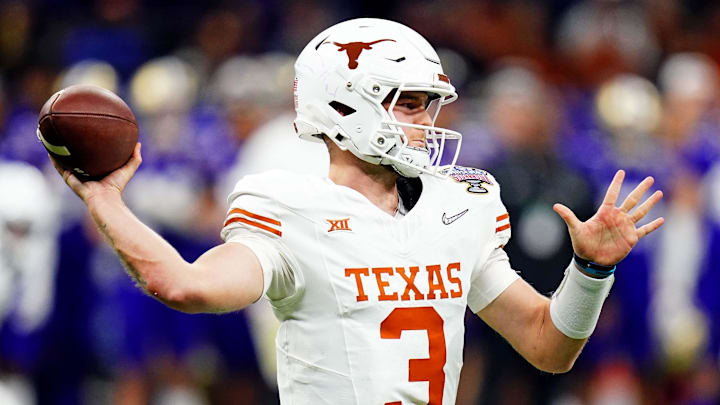Don’t Mess With Texas and Michigan’s Perfect Football Uniform Combination

College football often makes its first indelible imprint on fans as an overwhelming sensory experience. Games are a feast of tastes and smells at the tailgate; an eruption of sound in the stadium, from the fans and bands; and perhaps most of all, a striking visual immersion.
The colors. The helmets. The uniforms. How many of us have formed a bond at a young age with a school based on what the football team wears on fall Saturdays?
Saturday in Ann Arbor, Mich., the Texas Longhorns and Michigan Wolverines will provide an iconic visual for more than 100,000 people in the Big House and several million broadcast viewers. It will be the most predictable—but most fetching—of fit checks.
They’ll model two of the all-time looks—the Longhorns in their road whites, the Wolverines in their home maize and blue. They’re perfect.
The helmets have endured for decades as the most readily identifiable symbols of their entire universities. Texas’s lids have showcased the Longhorn logo since 1961 and Michigan’s “winged” look dates to ’38. (Truth be told, Michigan coach Fritz Crisler brought that design with him from Princeton, which can claim original use of the winged helmet but far less attachment to it.)
Michigan running back Jamie Morris, who played there in the 1980s and for a time was the school’s all-time leading rusher, had three older brothers who went to Syracuse. He chose to become a Wolverine.
“I just loved Michigan’s helmets,” he said years ago. “That’s why I came here.”
Woe unto any athletic director or coach who tries to change them.
“We’re the most traditional program in the country,” Texas athletic director Chris Del Conte said last year. “We have a great logo. We have great colors. It’s unique. … We don’t need to candy this stuff up. I firmly believe that.
“Every time you turn on the channel and you look across [the field], you know who the University of Texas is. That is what it’s all about. I always tell our kids, ‘Embrace who we are.’ It’s not old. It’s not stuffy. It’s Texas. It’s the best.”
These specific uniforms were what both schools wore in their biggest victories of the last 60 years.
Michigan was wearing the home blue jerseys on Jan. 1, 1998, when the Wolverines beat the Washington State Cougars in the Rose Bowl to claim a share of a national championship. It was wearing the same combination last Jan. 8 while walloping the Washington Huskies for the College Football Playoff championship. Those are the program’s only two national titles since ’48.
Texas was in its road gear—white helmet, white jersey with burnt-orange numerals and lettering, white pants—on Dec. 6, 1969, when it defeated the Arkansas Razorbacks in the “Game of the Century,” which paved the way to the national title. And it was wearing the same all-white outfits on Jan. 4, 2006, when Vince Young glided through the USC Trojans and into Texas lore in the Rose Bowl.
(The only noticeable Texas changes between 1969 and 2006 were the shoes going from black to white and the facemasks from gray to white. Aside from orange lettering and piping on the jersey and the Longhorn logo on the helmet, everything is now white. There was a flirtation with orange stripes on the pants in the 1970s and early ’80s, but those are long gone.)
This was also the uniform matchup the only other time Michigan and Texas played, in the 2005 Rose Bowl—Horns in white, Wolverines in blue. That was another game in which Young left a defense gasping and grasping in his wake. The Longhorns won that thriller 38–37.
So this is an exceedingly rare treat. Texas has played 1,374 games, dating back to 1893. Michigan has played 1,394 games, dating to 1879. This is only the second time they've come together on the field of strife.
My list of the best traditional home uniforms in college football is as follows:
- UCLA Bruins
- Michigan Wolverines
- USC Trojans
- Auburn Tigers
- Pittsburgh Panthers
My list of the best traditional road uniforms is shorter:
- Texas Longhorns
- LSU Tigers
“The moment we trot out in all-white on the road,” says former Texas All-American safety Michael Huff, “that’s special. Our uniform is so iconic.”
Huff, now a director of player development at Texas, was a star on the 2005 national championship team and is a current nominee for the National Football Foundation Hall of Fame. He was also very particular about his uniform, and particularly fond of the road whites. Before games, he would lay everything out on the floor—helmet, jersey, pants, shoes, shocks, wristbands, sleeves—and make sure it looked exactly the way he wanted it to look.
“The whites have to be crispy,” he says.
The complication, of course, is that white uniforms tend not to stay white very long. It’s a dirty sport. Games on natural grass leave stains. Blood is shed. Sweat comes in buckets. Collision streaks show up on helmets.
And as anyone who does laundry knows, it’s hard after a while to keep whites looking bright. Huff was a guy who would ask for new pants if the old ones started looking dingy.
“The equipment staff does a great job of keeping things clean and fresh,” Huff says. “The white uniforms especially have to be kept spic-and-span, looking brand new.”
Brand new, and yet enduringly old. Some programs love alternative uniforms—but those are usually places with less tradition. The places that have won forever—like Texas and Michigan—don’t mess with the looks that are associated with success.
“I don’t want seven different alternate jerseys and three different helmets,” Huff says. “It just speaks for itself. You don’t need anything different. Anywhere in the country, anywhere in the world, you see that Longhorn and know exactly what it is.”
